Image Spectral Resolution Enhancement for Mapping Native Plant Species in a Typical Area of the Three-River Headwaters Region, China
Abstract
:1. Introduction
2. Materials and Methods
2.1. Study Area
2.2. Grass Species and Samples Collection
2.3. Image Data Acquisition and Processing
2.4. Spectral Resolution Enhancement of HJ-1A MSI Imagery
2.4.1. Basic Model
2.4.2. Clustering for Extraction of Spectral Matrix of HSI and MSI
2.4.3. Weighted Spectral Angle for Transformation Matrix G
2.4.4. Model Application
2.5. Mapping Coverage of NPS
2.5.1. Feature Extraction
2.5.2. SVM and RF Regression
2.6. Evaluation Indexes of Spectral Enhancement Methods
3. Results
3.1. Predicted Spectra of the ISREM Compared with Those of the CRISP and SREM
3.1.1. Predicted Spectral Curve Comparison of the Three Algorithms
3.1.2. Statistical Comparison of the Three Algorithms
3.2. Coverage of NPS Provided by SVM and RF Regression
3.2.1. Result of SVM and RF Regression
3.2.2. Accuracy Evaluation
3.2.3. Degradation Map of Research Area
4. Discussion
4.1. Improvements of ISREM
4.2. Potential of Spectral Enhancement in Monitoring Grassland Degradation of the TRHR
5. Conclusions
Author Contributions
Funding
Acknowledgments
Conflicts of Interest
References
- Yang, S.; Feng, Q.; Liang, T.; Liu, B.; Zhang, W.; Xie, H. Modeling grassland above-ground biomass based on artificial neural network and remote sensing in the Three-River Headwaters Region. Remote Sens. Environ. 2018, 204, 448–455. [Google Scholar] [CrossRef]
- Ge, J.; Meng, B.; Liang, T.; Feng, Q.; Gao, J.; Yang, S.; Huang, X.; Xie, H. Modeling alpine grassland cover based on MODIS data and support vector machine regression in the headwater region of the Huanghe River, China. Remote Sens. Environ. 2018, 218, 162–173. [Google Scholar] [CrossRef]
- Shen, H.; Zhang, L.; Huang, B.; Li, P. A MAP approach for joint motion estimation, segmentation, and super resolution. IEEE Trans. Image Process. 2007, 16, 479–490. [Google Scholar] [CrossRef] [PubMed]
- Zhang, H.; Zhang, L.; Shen, H. A super-resolution reconstruction algorithm for hyperspectral images. Signal Process. 2012, 92, 2082–2096. [Google Scholar] [CrossRef]
- Zhang, L.; Zhang, H.; Shen, H.; Li, P. A super-resolution reconstruction algorithm for surveillance images. Signal Process. 2010, 90, 848–859. [Google Scholar] [CrossRef]
- Laben Craig, A.; Brower Bernard, V. Process for Enhancing the Spatial Resolution of Multispectral Imagery Using Pan-Sharpening. United States Patent US 6011875 A, 28 October 2015. [Google Scholar]
- Ai, Z.; An, R.; Chen, Y.; Huang, L. Comparison of hyperspectral HJ-1A/HSI and multispectral Landsat 8 and Sentinel-2A imagery for estimating alpine grassland coverage in the Three-River Headwaters region. J. Appl. Remote Sens. 2019, 13, 014504. [Google Scholar] [CrossRef]
- Chi, M.; Feng, R.; Bruzzone, L. Classification of hyperspectral remote-sensing data with primal SVM for small-sized training dataset problem. Adv. Space Res. 2008, 41, 1793–1799. [Google Scholar] [CrossRef]
- Sun, X.; Zhang, L.; Yang, H.; Wu, T.; Cen, Y.; Guo, Y. Enhancement of Spectral Resolution for Remotely Sensed Multispectral Image. IEEE J. Sel. Top. Appl. Earth Obs. Remote Sens. 2014, 8, 1–14. [Google Scholar] [CrossRef]
- Winter, M.E.; Winter, E.M.; Beaven, S.G.; Ratkowski, A.J. Hyperspectral image sharpening using multispectral data. Def. Secur. 2005, 5806, 794–803. [Google Scholar] [CrossRef]
- Liu, J.; Xu, X.; Shao, Q. Grassland degradation in the “Three-River Headwaters” region, Qinghai Province. J. Geogr. Sci. 2008, 18, 259–273. [Google Scholar] [CrossRef]
- Fan, J.-W.; Shao, Q.-Q.; Liu, J.-Y.; Wang, J.-B.; Harris, W.; Chen, Z.-Q.; Zhong, H.-P.; Xu, X.-L.; Liu, R.-G. Assessment of effects of climate change and grazing activity on grassland yield in the Three Rivers Headwaters Region of Qinghai–Tibet Plateau, China. Environ. Monit. Assess. 2009, 170, 571–584. [Google Scholar] [CrossRef] [PubMed]
- Wang, X.; Dong, S.; Yang, B.; Li, Y.; Su, X. The effects of grassland degradation on plant diversity, primary productivity, and soil fertility in the alpine region of Asia’s headwaters. Environ. Monit. Assess. 2014, 186, 6903–6917. [Google Scholar] [CrossRef] [PubMed]
- Shen, X.-J.; An, R.; Feng, L.; Ye, N.; Zhu, L.; Li, M. Vegetation changes in the Three-River Headwaters Region of the Tibetan Plateau of China. Ecol. Indic. 2018, 93, 804–812. [Google Scholar] [CrossRef]
- Tong, Q.; Xue, Y.; Zhang, L. Progress in Hyperspectral Remote Sensing Science and Technology in China Over the Past Three Decades. IEEE J. Sel. Top. Appl. Earth Obs. Remote Sens. 2013, 7, 70–91. [Google Scholar] [CrossRef]
- Liang, T.; Yang, S.; Feng, Q.; Liu, B.; Zhang, R.; Huang, X.; Xie, H. Multi-factor modeling of above-ground biomass in alpine grassland: A case study in the Three-River Headwaters Region, China. Remote Sens. Environ. 2016, 186, 164–172. [Google Scholar] [CrossRef]
- Ru, A.; Caihong, L.; Huilin, W.; Daping, J.; Mengqiu, S.; Ballard, J.A.Q. Remote sensing identification of rangeland degradation using Hyperion HSI in a typical area for Three-River Headwater Region. Geomat. Inf. Sci. Wuhan Univ. 2018, 3, 399–405. (In Chinese) [Google Scholar] [CrossRef]
- Xu, S.; Shang, Z. The Three-stage Species Niche and Reproductive Characteristics of Poisonous Weeds in the three-stages of the Secondary Vegetation’s Formation of ‘bare land’ degraded grassland in the Three Rivers Source region, Qinghai-Tibetan plateau. Acta Agrestia Sin. 2019, 27, 949–955. (In Chinese) [Google Scholar] [CrossRef]
- Ai, Z.; An, R.; Lu, C.; Chen, Y. Mapping of native plant species and noxious weeds to investigate grassland degradation in the Three-River Headwaters region using HJ-1A/HSI imagery. Int. J. Remote Sens. 2019, 41, 1813–1838. [Google Scholar] [CrossRef]
- Niu, L.M.; Meng, J.H.; Wu, B.F.; Chen, X.Y.; DU, X.; Zhang, F.F. Research on standard preprocessing flow for HJ-1A HSI level 2 data product. Remote Sens. Land Resour. 2011, 1, 77–82. (In Chinese) [Google Scholar]
- Teillet, P.; Guindon, B.; Goodenough, D. On the Slope-Aspect Correction of Multispectral Scanner Data. Can. J. Remote Sens. 1982, 8, 84–106. [Google Scholar] [CrossRef] [Green Version]
- Yokoya, N.; Grohnfeldt, C.; Chanussot, J. Hyperspectral and Multispectral Data Fusion: A comparative review of the recent literature. IEEE Geosci. Remote Sens. Mag. 2017, 5, 29–56. [Google Scholar] [CrossRef]
- Adam, E.; Mutanga, O.; Rugege, D. Multispectral and hyperspectral remote sensing for identification and mapping of wetland vegetation: A review. Wetl. Ecol. Manag. 2009, 18, 281–296. [Google Scholar] [CrossRef]
- Loncan, L.; Almeida, L.B.; Bioucas-Dias, J.M.; Briottet, X.; Chanussot, J.; Dobigeon, N.; Fabre, S.; Liao, W.; Licciardi, G.A.; Simoes, M.; et al. Hyperspectral Pansharpening: A Review. IEEE Geosci. Remote Sens. Mag. 2015, 3, 27–46. [Google Scholar] [CrossRef] [Green Version]
- Heylen, R.; Parente, M.; Gader, P. A Review of Nonlinear Hyperspectral Unmixing Methods. IEEE J. Sel. Top. Appl. Earth Obs. Remote Sens. 2014, 7, 1844–1868. [Google Scholar] [CrossRef]
- Zhuang, L.; Zhang, B.; Gao, L.; Li, J.; Plaza, J. Normal Endmember Spectral Unmixing Method for Hyperspectral Imagery. IEEE J. Sel. Top. Appl. Earth Obs. Remote Sens. 2014, 8, 2598–2606. [Google Scholar] [CrossRef]
- Hughes, G. On the mean accuracy of statistical pattern recognizers. IEEE Trans. Inf. Theory 1968, 14, 55–63. [Google Scholar] [CrossRef] [Green Version]
- Du, P.J.; Xia, J.S.; Xue, Z.H.; Tan, K.; Su, H.J.; Bao, R. Review of hyperspectral remote sensing image classification. J. Remote Sens. 2016, 2, 236–256. (In Chinese) [Google Scholar] [CrossRef]
- McGwire, K. Hyperspectral Mixture Modeling for Quantifying Sparse Vegetation Cover in Arid Environments. Remote Sens. Environ. 2000, 72, 360–374. [Google Scholar] [CrossRef]
- Lin, H.-J.; Zhang, H.-F.; Gao, Y.-Q.; Li, X.; Yang, F.; Zhou, Y.-F. Mahalanobis distance based hyperspectral characteristic discrimination of leaves of different desert tree species. Guang Pu Xue Yu Guang Pu Fen Xi = Guang Pu 2014, 34, 3358–3362. [Google Scholar]
- Lu, Q.; Zhao, N.; Wu, S.; Dai, E.; Gao, J. Using the NDVI to analyze trends and stability of grassland vegetation cover in Inner Mongolia. Theor. Appl. Clim. 2018, 135, 1629–1640. [Google Scholar] [CrossRef]
- Payero, J.O.; Neale, C.M.U.; Wright, J.L. Comparison of eleven vegetation indices for estimating plant height of alfalfa and grass. Appl. Eng. Agric. 2004, 20, 385–393. [Google Scholar] [CrossRef] [Green Version]
- Mutanga, O.; Skidmore, A.K. Narrow band vegetation indices overcome the saturation problem in biomass estimation. Int. J. Remote Sens. 2004, 25, 3999–4014. [Google Scholar] [CrossRef]
- Asner, G.P.; Jones, M.O.; Martin, R.E.; Knapp, D.; Hughes, R.F. Remote sensing of native and invasive species in Hawaiian forests. Remote Sens. Environ. 2008, 112, 1912–1926. [Google Scholar] [CrossRef]
- Rosso, P.H.; Ustin, S.L.; Hastings, A. Mapping marshland vegetation of San Francisco Bay, California, using hyperspectral data. Int. J. Remote Sens. 2005, 26, 5169–5191. [Google Scholar] [CrossRef]
- Tucker, C.J. Red and photographic infrared linear combinations for monitoring vegetation. Remote Sens. Environ. 1979, 8, 127–150. [Google Scholar] [CrossRef] [Green Version]
- Gitelson, A.A.; Kaufman, Y.J.; Merzlyak, M.N. Use of a green channel in remote sensing of global vegetation from EOS-MODIS. Remote Sens. Environ. 1996, 58, 289–298. [Google Scholar] [CrossRef]
- Botha, E.; LeBlon, B.; Zebarth, B.; Watmough, J. Non-destructive estimation of potato leaf chlorophyll from canopy hyperspectral reflectance using the inverted PROSAIL model. Int. J. Appl. Earth Obs. Geoinf. 2007, 9, 360–374. [Google Scholar] [CrossRef]
- Datt, B. A New Reflectance Index for Remote Sensing of Chlorophyll Content in Higher Plants: Tests using Eucalyptus Leaves. J. Plant Physiol. 1999, 154, 30–36. [Google Scholar] [CrossRef]
- Gamon, J.A.; Serrano, L.; Surfus, J.S. The photochemical reflectance index: An optical indicator of photosynthetic radiation use efficiency across species, functional types, and nutrient levels. Oecologia 1997, 112, 492–501. [Google Scholar] [CrossRef]
- Mountrakis, G.; Im, J.; Ogole, C. Support vector machines in remote sensing: A review. ISPRS J. Photogramm. Remote Sens. 2011, 66, 247–259. [Google Scholar] [CrossRef]
- Antonarakis, A.S.; Richards, K.; Brasington, J. Object-based land cover classification using airborne LiDAR. Remote Sens. Environ. 2008, 112, 2988–2998. [Google Scholar] [CrossRef]
- Pandey, P.C.; Koutsias, N.; Petropoulos, G.P.; Srivastava, P.K.; Ben Dor, E. Land use/land cover in view of earth observation: Data sources, input dimensions, and classifiers—A review of the state of the art. Geocarto Int. 2019, 1–32. [Google Scholar] [CrossRef]
- Fauvel, M.; Benediktsson, J.A.; Chanussot, J.; Sveinsson, J.R. Spectral and Spatial Classification of Hyperspectral Data Using SVMs and Morphological Profiles. IEEE Trans. Geosci. Remote Sens. 2008, 46, 3804–3814. [Google Scholar] [CrossRef] [Green Version]
- Dixon, B.; Candade, N. Multispectral landuse classification using neural networks and support vector machines: One or the other, or both? Int. J. Remote Sens. 2007, 29, 1185–1206. [Google Scholar] [CrossRef]
- Du, P.; Tan, K.; Xing, X. A novel binary tree support vector machine for hyperspectral remote sensing image classification. Opt. Commun. 2012, 285, 3054–3060. [Google Scholar] [CrossRef]
- Van Der Linden, S.; Rabe, A.; Held, M.; Jakimow, B.; Leitão, P.J.; Okujeni, A.; Schwieder, M.; Suess, S.; Hostert, P. The EnMAP-Box—A Toolbox and Application Programming Interface for EnMAP Data Processing. Remote Sens. 2015, 7, 11249–11266. [Google Scholar] [CrossRef] [Green Version]
- Peerbhay, K.; Mutanga, O.; Lottering, R.; Ismail, R. Mapping Solanum mauritianum plant invasions using WorldView-2 imagery and unsupervised random forests. Remote Sens. Environ. 2016, 182, 39–48. [Google Scholar] [CrossRef]
- Belgiu, M.; Drăguț, L. Random forest in remote sensing: A review of applications and future directions. ISPRS J. Photogramm. Remote Sens. 2016, 114, 24–31. [Google Scholar] [CrossRef]
- Feng, Q.; Liu, J.; Gong, J. UAV Remote Sensing for Urban Vegetation Mapping Using Random Forest and Texture Analysis. Remote Sens. 2015, 7, 1074–1094. [Google Scholar] [CrossRef] [Green Version]
- Kruse, F.; Lefkoff, A.; Boardman, J.; Heidebrecht, K.; Shapiro, A.; Barloon, P.; Goetz, A. The spectral image processing system (SIPS)—Interactive visualization and analysis of imaging spectrometer data. Remote Sens. Environ. 1993, 44, 145–163. [Google Scholar] [CrossRef]
- Ranchin, T.; Wald, L. Fusion of high spatial and spectral resolution images: The ARSIS concept and its implementation. Photogramm. Eng. Remote Sens. 2000, 66, 49–61. [Google Scholar]
- Wang, Z.; Bovik, A.C. A universal image quality index. IEEE Signal Process. Lett. 2002, 9, 81–84. [Google Scholar] [CrossRef]
- Wang, G.; Zhang, L.; Sun, X.; Yang, H.; Jiang, H.; Tong, Q. Mineral alteration information extraction based on SREM fusion data. Editor. Comm. Earth Sci. J. China Univ. Geosci. 2015, 8, 1330–1338. (In Chinese) [Google Scholar] [CrossRef]
- Pan, D. Study on the Types and Grade Partition Criterion of “Black Soil Type” Degraded Grassland in the “Three-River Headwater” Region. Master’s Thesis, Gansu Agricultural University, Lanzhou, China, 2007. (In Chinese). [Google Scholar]
- Meng, X.; Shen, H.; Li, H.; Zhang, L.; Fu, R. Review of the pansharpening methods for remote sensing images based on the idea of meta-analysis: Practical discussion and challenges. Inf. Fusion 2019, 46, 102–113. [Google Scholar] [CrossRef]
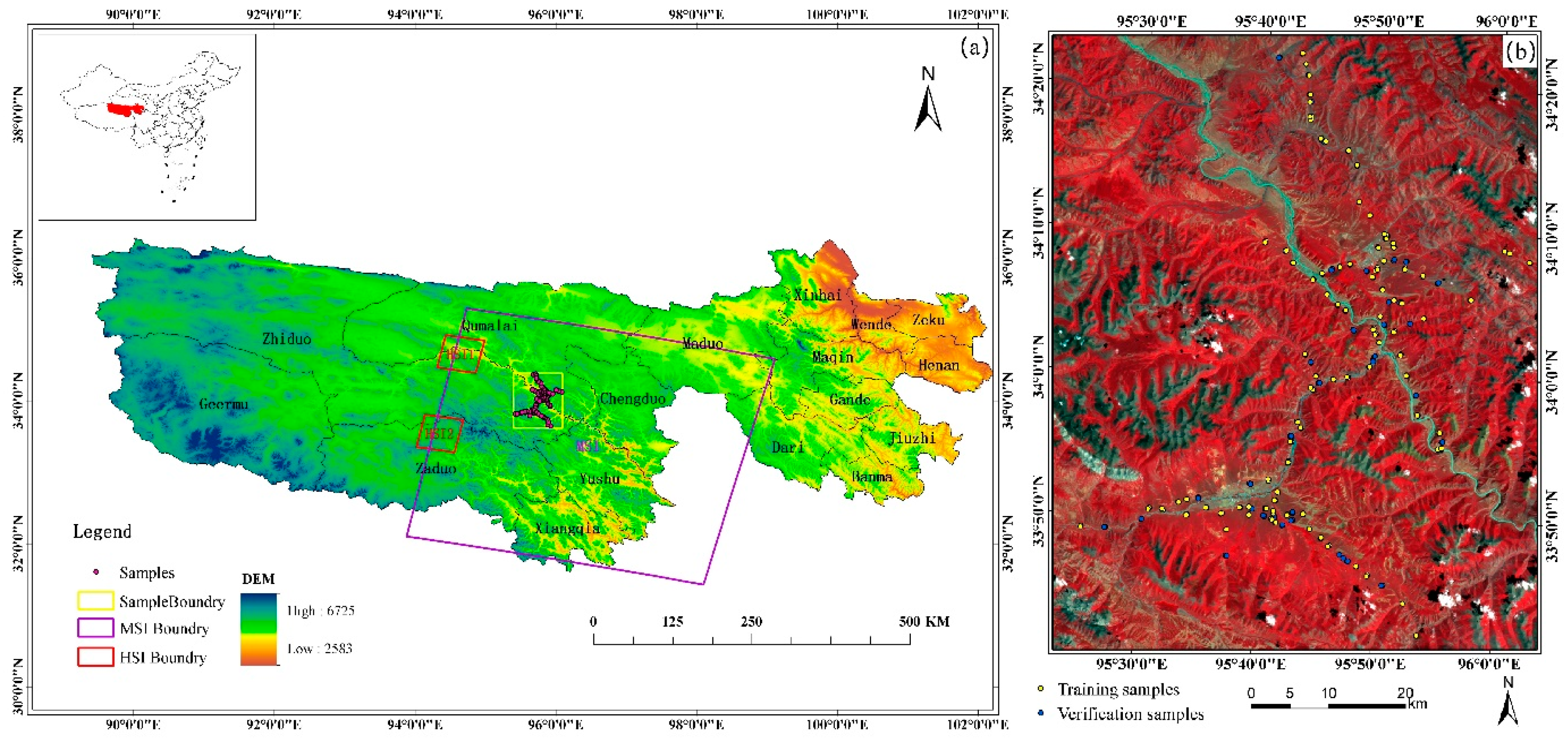
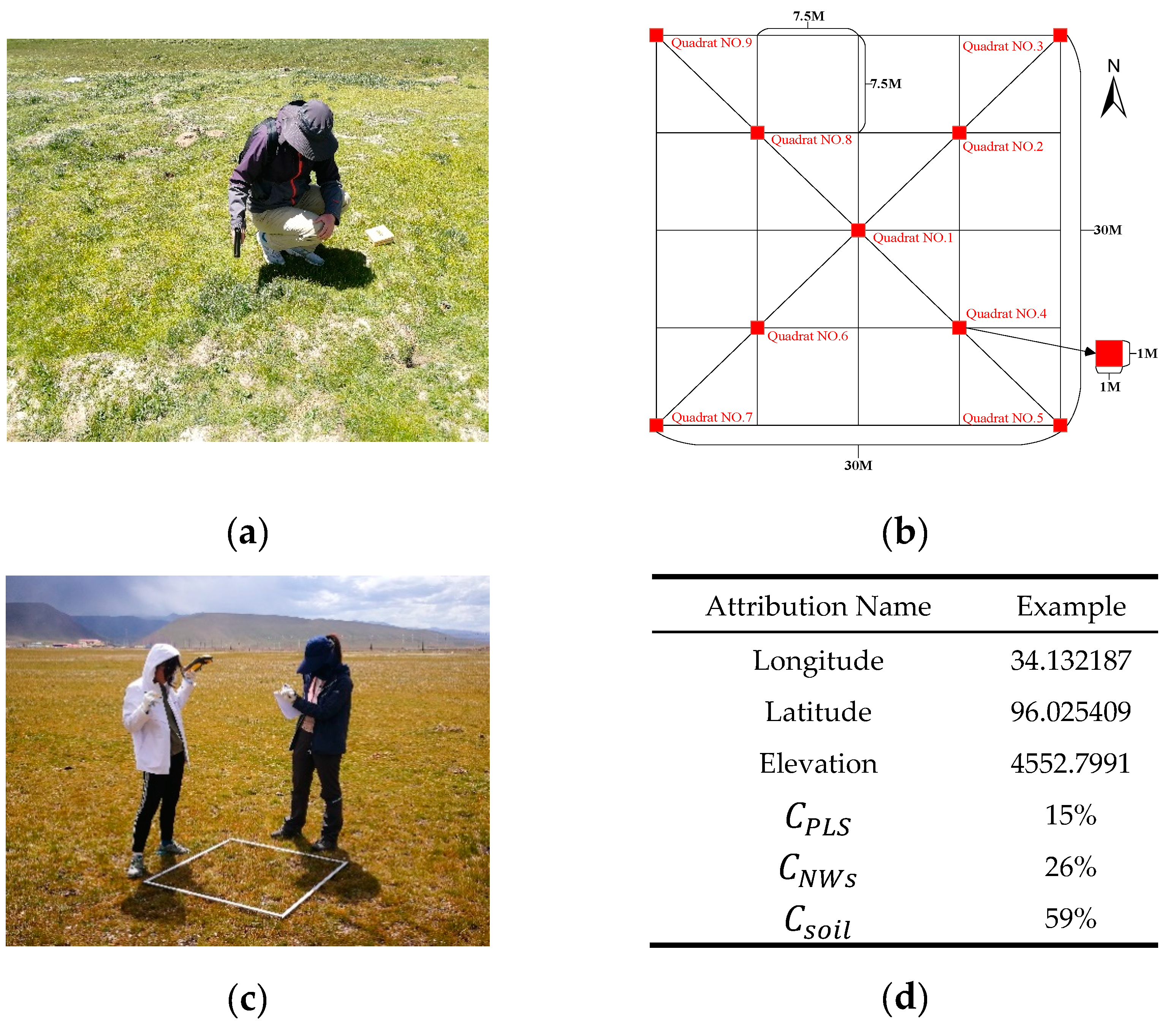
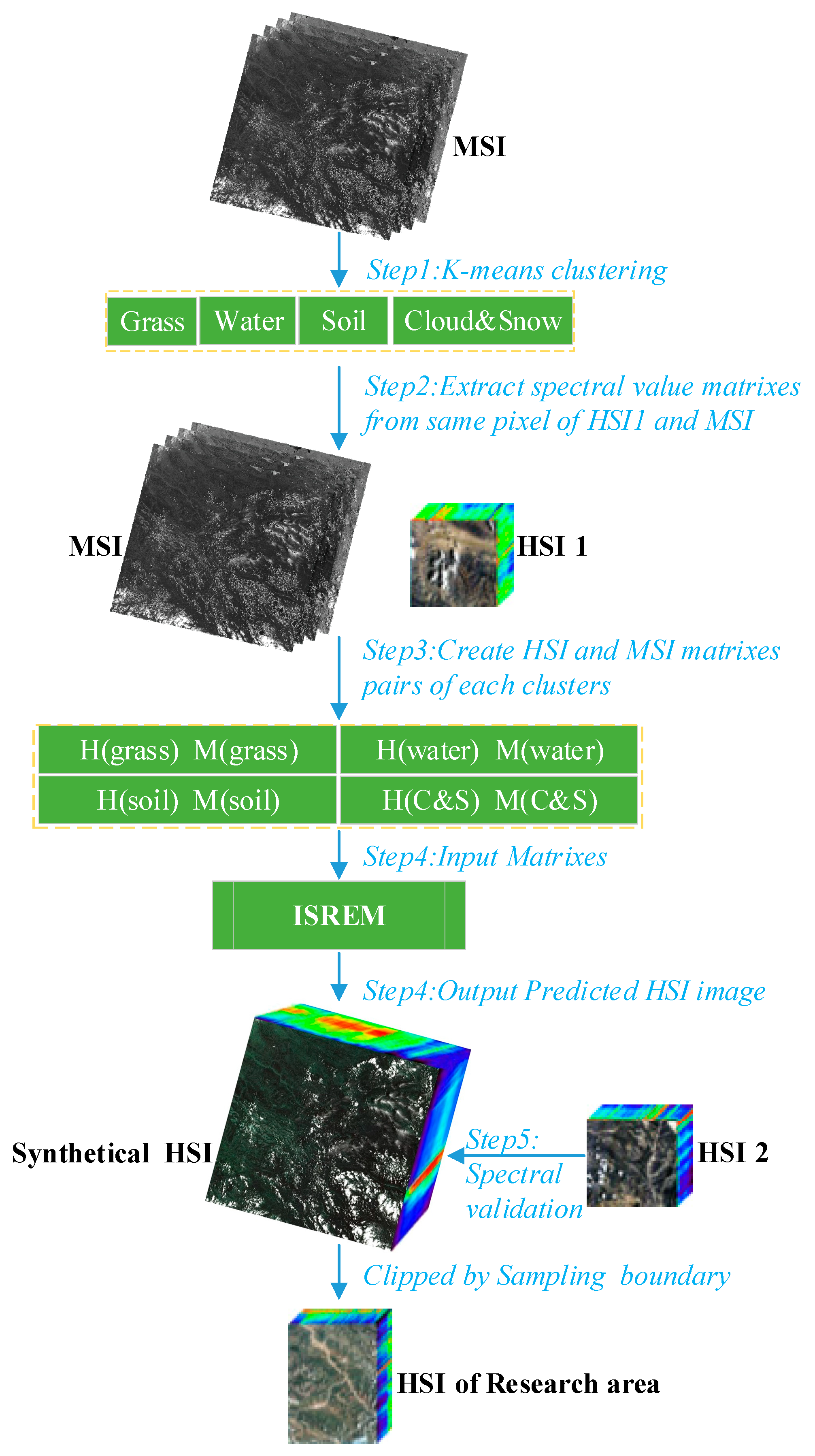
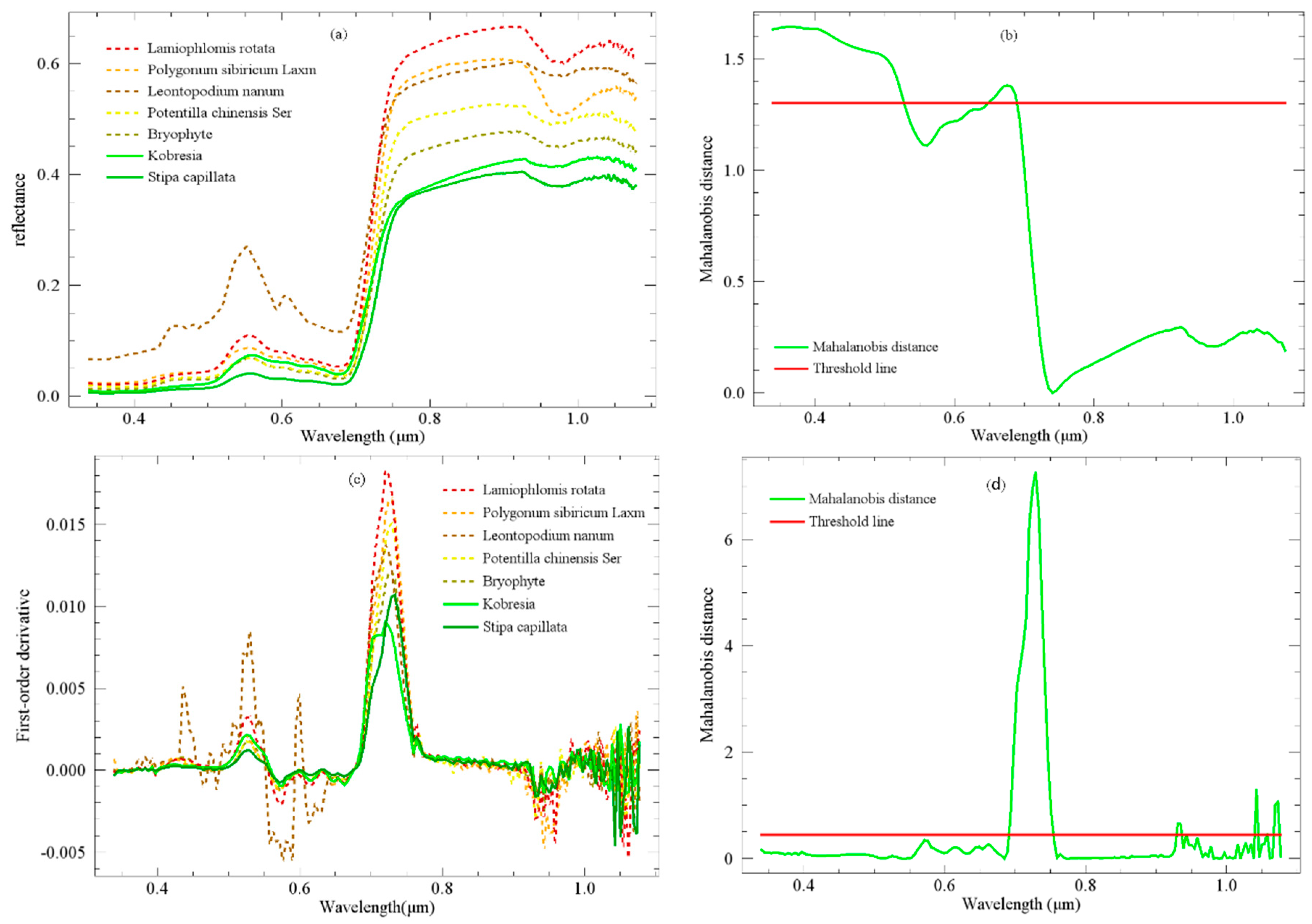

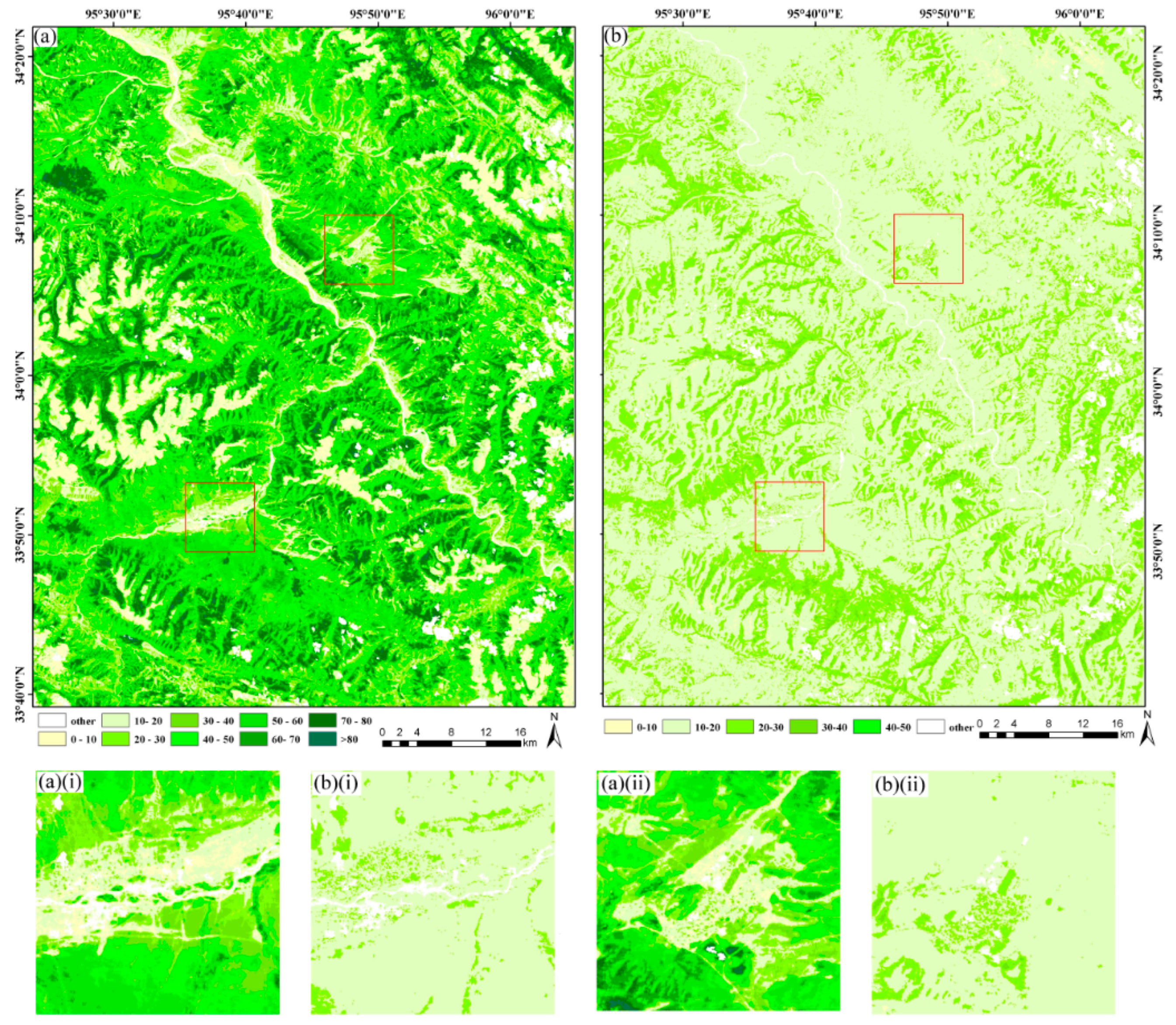
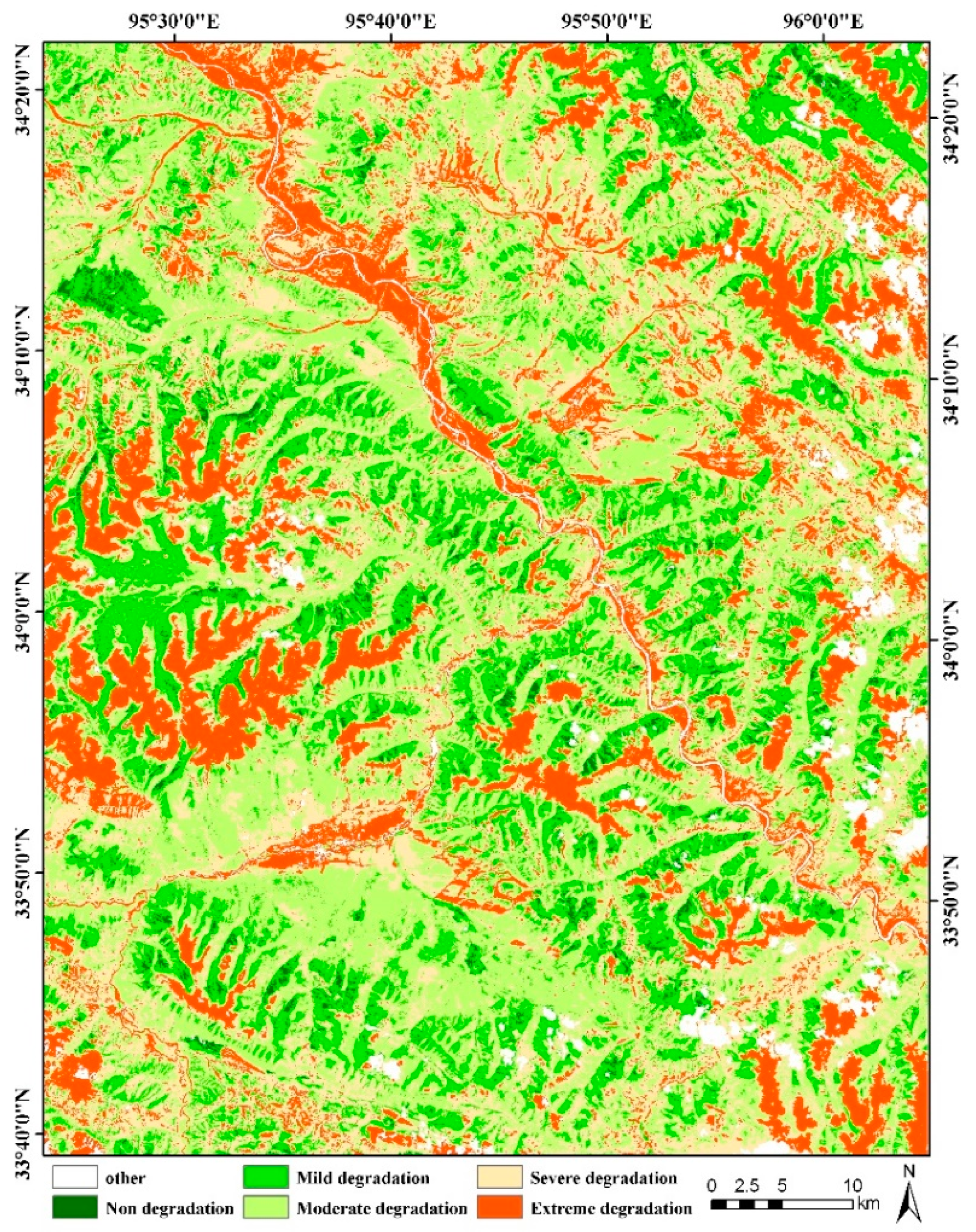
| HJ-1A | Bands (nm) | Spatial Resolution (m) | |
|---|---|---|---|
| MSI | Band1 430–520 | Band3 630–690 | 30 |
| Band2 520–600 | Band4 760–900 | ||
| HSI | Band1-Band26 | Band61-Band88 | 100 |
| 460.04–518.81 | 631.805–759.39 | ||
| Band27-Band60 | Band89-Band115 | ||
| 521.475–627.895 | 765.11–951.54 | ||
| Feature Type | Spectrum (nm) | Bands of HJ-1A/I | Number of Bands |
|---|---|---|---|
| Original spectra | 340–523 645–693 | band 1 to 28 band 65 to 75 | 39 |
| First-order derivative spectra | 689–755 | band 75 to 87 | 13 |
| VI | Full Name | Formula | Reference |
|---|---|---|---|
| NDVI | Normalized difference vegetation index | (R900 − R680)/((R900 + R680) | [36] |
| nGNDVI | Narrowband green normalized difference vegetation index | (R780 − R550)/((R780 + R550) | [37] |
| nNDVI | Narrowband normalized difference vegetation index | (R800 − R670)/((R800 + R670) | [36] |
| nLCI | Narrowband leaf chlorophyll index | (R850 − R710)/((R850 + R680) | [38] |
| ARI2 | Anthocyanin reflectance index 2 | R800 * [(R550)−1 − (R700)−1] | [39] |
| nPRI | Narrowband photochemical reflectance index | (R550 − R530)/(R550 + R530) | [40] |
| Bands | Pearson’s r of Three Algorithms | ||
|---|---|---|---|
| ISREM | SREM | CRISP | |
| B02 | 0.9300 | 0.9229 | 0.9031 |
| B39 | 0.9539 | 0.9511 | 0.9512 |
| B61 | 0.9625 | 0.9635 | 0.9649 |
| B107 | 0.9716 | 0.9410 | 0.9534 |
| Average Value | 0.9582 | 0.9514 | 0.9480 |
| ISREM | SREM | CRISP | |
|---|---|---|---|
| SAM | 8.5591 | 17.9642 | 21.8500 |
| ERGAS | 0.0481 | 0.0492 | 0.0580 |
| UIQI | 0.7901 | 0.6628 | 0.6771 |
| Type | SVM Regression | RF Regression | ||||||
|---|---|---|---|---|---|---|---|---|
| MSI | SREM | CRISP | ISREM | MSI | SREM | CRISP | ISREM | |
| Count of 0–10% | 53 | 52 | 53 | 54 | 49 | 49 | 50 | 52 |
| Proportion (%) | 68.83 | 67.53 | 68.83 | 70.13 | 63.64 | 63.64 | 64.94 | 67.53 |
| Count of 0–20% | 69 | 69 | 70 | 72 | 69 | 70 | 70 | 71 |
| Proportion (%) | 89.61% | 89.61% | 90.91% | 93.51% | 89.61% | 90.91% | 90.91% | 92.21% |
| Degradation Level | Non | Mild | Moderate | Severe | Extreme | Mask |
|---|---|---|---|---|---|---|
| Area (numbers of pixels) | 78,392 | 1,033,373 | 1,966,572 | 1,434,292 | 979,152 | 171,263 |
| Proportion of grassland (%) | 1.43 | 18.81 | 35.81 | 26.12 | 17.83 | / |
| Proportion of the study area (%) | 1.38 | 18.25 | 34.73 | 25.33 | 17.29 | 3.02 |
© 2020 by the authors. Licensee MDPI, Basel, Switzerland. This article is an open access article distributed under the terms and conditions of the Creative Commons Attribution (CC BY) license (http://creativecommons.org/licenses/by/4.0/).
Share and Cite
Wang, B.; An, R.; Jiang, T.; Xing, F.; Ju, F. Image Spectral Resolution Enhancement for Mapping Native Plant Species in a Typical Area of the Three-River Headwaters Region, China. Remote Sens. 2020, 12, 3146. https://doi.org/10.3390/rs12193146
Wang B, An R, Jiang T, Xing F, Ju F. Image Spectral Resolution Enhancement for Mapping Native Plant Species in a Typical Area of the Three-River Headwaters Region, China. Remote Sensing. 2020; 12(19):3146. https://doi.org/10.3390/rs12193146
Chicago/Turabian StyleWang, Benlin, Ru An, Tong Jiang, Fei Xing, and Feng Ju. 2020. "Image Spectral Resolution Enhancement for Mapping Native Plant Species in a Typical Area of the Three-River Headwaters Region, China" Remote Sensing 12, no. 19: 3146. https://doi.org/10.3390/rs12193146







